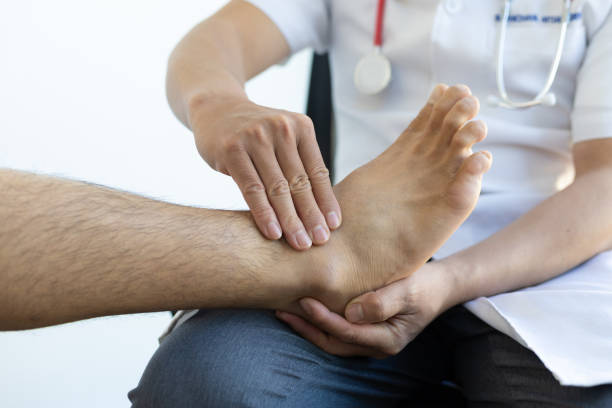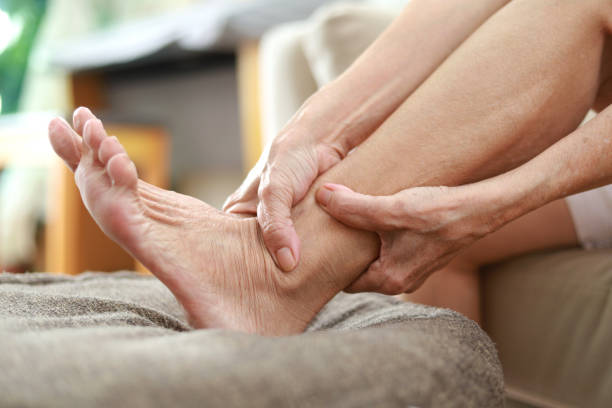Foot and ankle injuries can be debilitating, especially if they keep you from participating in your favorite activities. Many injuries can be treated at home with RICE—rest, ice, compression and elevation.
A podiatrist can diagnose the extent of your injury with an exam and may order X-rays or ultrasounds. They can also recommend a treatment plan for you that includes pain management techniques like ice and electrical stimulation treatments.

Rest
The ankle is a complex joint where three bones meet — the tibia and fibula of your lower leg, and the talus of your foot. These bones are held together by ligaments and supported by muscles and tendons. An injury to any one of these structures can cause pain, swelling and limited mobility.
When you have an ankle injury, rest is key. This means limiting your activities and using crutches to take the weight off your ankle. Applying ice several times a day to reduce inflammation and swelling also helps.
Once the pain is reduced, physical therapy can include strengthening exercises that work to improve your balance and strength. This can help prevent future injuries, as strong muscles can buffer your feet and ankles against stress and strain.
Ice
Injuries to the bones, joints and soft tissue (muscles, ligaments and tendons) of the foot and ankle can be very serious. They may occur when playing sports, exercising or as a result of an accident.
Ice is important after a foot or ankle injury because it reduces pain, swelling and bruising and can help numb the area. It should be applied to the skin using a cloth or towel to prevent skin burns. It should not be used for more than 20 minutes at a time because prolonged exposure can cause skin damage and can make the pain worse.
If you’re dealing with a severe foot or ankle injury, you can schedule an examination, diagnosis, and treatment appointment at The Foot Clinic. Visit thefootclinic.net to book your appointment. This can help prevent complications such as a torn ligament or bone fracture.

Compression
Foot and ankle injuries are common, especially for people who exercise regularly. Often, the injuries are minor and heal in weeks with proper treatment. However, severe injuries, such as fractures, may need to be treated with immobilization.
Podiatrists recommend following the RICE (rest, ice, compression and elevation) method for treating foot and ankle injuries. This helps to reduce swelling and prevent stiffness.
It is also helpful to gently massage the injured area. This can help to reduce pain and increase blood flow to the area. Wrapping the injury in an Ace bandage is also recommended, but be careful not to wrap it too tightly, which can restrict circulation. Keeping the injured foot elevated, by placing it on several pillows, can also decrease swelling. Using shoe inserts and wearing shoes that fit well and have good support can also decrease foot and ankle injury.
Heat
The foot and ankle are complex structures with 26 tiny bones, 30 joints and over 100 muscles and tendons. Minor injuries such as sprains, strains and ligament tears can often be treated at home with RICE – rest, ice, compression and elevation – but seeing a podiatrist is always recommended so the injury can be monitored and healing fostered.
Applying ice to the injured area constricts blood vessels, decreasing swelling and bruising. The cold also numbs nerves and tissues, which reduces pain and inflammation. This can be done with a bag of frozen peas, a cold towel or by soaking the foot in a cold bath.
Massage
The foot and ankle are a critical link in the body’s structure, movement, support and balance. When injury occurs in the foot and ankle, it can affect many areas of the body, including the knee, hip and lower back.
Mild injuries such as sprains can often be treated at home. It’s important to rest the injured area, use nonsteroidal anti-inflammatory drugs (such as paracetamol) and ice packs to reduce swelling and pain. Gently massaging the injured area and elevating it above your heart will also help to reduce swelling.
Foot massage has been shown to aid joint and muscle soreness after injury. Combining massage with strengthening and stretching exercises can prevent future foot and ankle injuries as well as speed up recovery from current injuries.
Foot Orthotics
As the foundation for your whole body, your feet support your weight and take in much of the impact of running, jumping and walking. Improper foot alignment, however, can cause pain in the legs, knees, hips and back.
Depending on your problem, podiatry Shenton Park may prescribe shoe inserts called orthotics to help correct these problems. These devices are designed to work like shock absorbers in your shoes, taking pressure off of painful areas and helping your muscles relax. They can also decrease muscle fatigue, boosting vital energy levels and securing optimal and efficient muscle performance. These orthotics are available in custom-made and over-the-counter forms. Each type has its own specific features, benefits and limitations. Your podiatrist can explain the differences.
Surgery
Most sprains and strains can be treated with rest, ice, compression and elevation. In severe cases or when the injury doesn’t heal within expected timeframes surgery may be required.
Some foot and ankle surgeries are designed to improve appearance (such as bunion surgery) while others, such as joint fusion and osteotomy, realign bones and tendons to reduce pain and provide better function. These types of procedures can take longer to heal and limit your movement, but they do provide long-lasting benefits such as improved pain relief and greater footwear selection.
Other treatments for foot and ankle injuries include exercises, shoe inserts/orthoses and specially modified shoes. Pain-relieving medications can also help with the pain and stiffness that are often associated with foot and ankle injuries.

 November 27th, 2023
November 27th, 2023  adminva2
adminva2  Posted in
Posted in